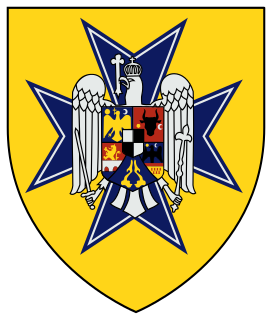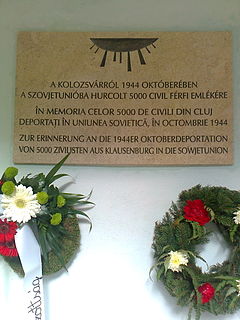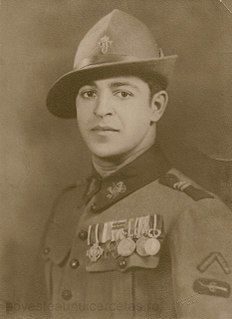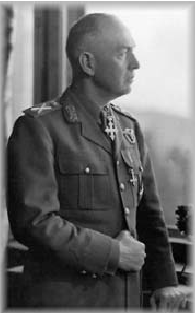
Organisation Todt (OT) was a civil and military engineering organisation in Nazi Germany from 1933 to 1945, named for its founder, Fritz Todt, an engineer and senior Nazi. The organization was responsible for a huge range of engineering projects both in pre-World War II Germany, in Germany itself and occupied territories from France to the Soviet Union during the war. It became notorious for using forced labour. From 1943-45 during the late phase of the Third Reich, OT administered all constructions of concentration camps to supply forced labor to industry.

The Palace of the Parliament (Romanian: Palatul Parlamentului) is the seat of the Parliament of Romania. Located on Dealul Arsenalului in the national capital city of central Bucharest (Sector 5), it is the second largest administrative building in the world. The Palace has a height of 84 metres (276 ft), a floor area of 365,000 square metres (3,930,000 sq ft) and a volume of 2,550,000 cubic metres (90,000,000 cu ft). The Palace of the Parliament is the heaviest building in the world, weighing about 4,098,500,000 kilograms (9.0356×109 lb).

Edineț is a town and municipality in the north of Moldova. It is the administrative center of the eponymous district. The town is located 201 km north of the national capital, Chișinău. It is located at 48°10′N27°19′E. The town administers also two suburban villages, Alexăndreni and Gordineştii Noi. The population at the 2004 census was 17,292, including 15,624 in the town itself.

Konstantin Hierl was a major figure in the administration of Nazi Germany. He was the head of the Reich Labour Service and an associate of Adolf Hitler before he came to national power.

The Reich Labour ServiceReichsarbeitsdienst; RAD) was a major organisation established in Nazi Germany as an agency to help mitigate the effects of unemployment on the German economy, militarise the workforce and indoctrinate it with Nazi ideology. It was the official state labour service, divided into separate sections for men and women.

Iustin Moisescu was Patriarch of the Romanian Orthodox Church from 1977 to 1986.

Straja Țării was a youth organization in the Kingdom of Romania, created in 1935 by King Carol II to counter the growing influence the Iron Guard had over the youth of Romania. Its members were known as străjeri ("sentinels"), and used a form of the Roman salute as greeting.
Mihai Rădulescu was a Romanian novelist, poet, historian and art critic.

SLOMR was a Romanian free trade union founded, without prior preparation, in February 1979, as a means to oppose the control exercised by the ruling Communist Party during the country's communist period. Initiated along the same lines as Solidarity, created one year later in the People's Republic of Poland, it grew to about 2,400 adherents within four weeks, and was dismantled by the authorities of Nicolae Ceauşescu's regime, coordinated by the Securitate, over the next three months.

Corpul Muncitoresc Legionar or Corpul Muncitorilor Legionari was a fascist association of workers in Romania, created inside the Iron Guard and having a rigid hierarchical structure. From its creation until September 1940, the CML was led by Gheorghe Clime; afterwards, the position was filled by Dumitru Groza, who oversaw the Corps during the period when the Iron Guard was in power — the National Legionary State —, and involved it in the 1941 Rebellion and Pogrom. The CML had its headquarters in Bucharest, on Calea Călăraşilor.

The Romanian Union Conference of Seventh-day Adventists is Romania's seventh-largest religious body. At the 2011 census, 85,902 Romanians declared themselves to be Seventh-Day Adventists. The church put its own membership at 64,791 in 2017. Ethnically, in 2002, they were 83.5% Romanians, 9.7% Hungarians, 4.9% Roma, 1.4% Ukrainians and 0.5% belonged to other groups. The denomination has 1,185 church buildings and some 340 pastors. It originates in the 19th century and is divided into six local conferences, standing for and named after some of the country's main historical regions: Banat, Northern Transylvania, Southern Transylvania, Moldavia, Muntenia and Oltenia.

The topic of forced labor of Hungarians in the Soviet Union in the aftermath of World War II was not researched until the fall of Communism and the dissolution of the Soviet Union. While exact numbers are not known, it is estimated that up to 600,000 Hungarians were captured altogether, including an estimated 200,000 civilians. An estimated 200,000 citizens perished. It was part of a larger system of the usage of foreign forced labor in the Soviet Union.
During the Soviet occupation, the religious life in Bessarabia and Northern Bukovina underwent a persecution similar to the one in Russia between the two World Wars. In the first days of occupation, certain population groups welcomed the Soviet power and some of them joined the newly established Soviet nomenklatura, including NKVD, the Soviet political police. The latter has used these locals to find and arrest numerous priests. Other priests were arrested and interrogated by the Soviet NKVD itself, then deported to the interior of the USSR, and killed. Research on this subject is still at an early stage. As of 2007, the Christian Orthodox church has granted the martyrdom to circa 50 clergymen who died in the first year of Soviet occupation (1940–1941).
Igor Caşu is a historian from the Republic of Moldova.

Ioan Dem. Dimǎncescu was a Romanian army officer, with a degree in physical education. He participated in the Boys and Girls Scout programs of Romania and was a scout leader.
The National Popular Party was an antifascist political party in Romania, founded during World War II as the underground Union of Patriots. The latter had defined itself as a spontaneous movement of resistance to the dictatorial regime of Ion Antonescu, but was largely known as a front for the illegal Romanian Communist Party. Its founders—Dumitru Bagdasar, Gheorghe Vlădescu-Răcoasa, Simion Stoilow—were closely cooperating with PCdR men, but also with liberal opposition forces. Repressed by the authorities, the UP made a comeback after the pro-Allied August 23 Coup of 1944, when it endured as a small ally of the communists—mostly controlled directly by them, but sometimes rebellious.

Alexandru Bassarab, or Basarab, was a Romanian painter, engraver, and fascist politician. Earning his reputation for his pioneering work in linocut and woodcut, he explored neotraditionalism, Romanian nationalism, and Romanian folklore, and was ultimately drawn into politics with the Iron Guard. He helped steer several art groups associated or integrated with the Guard, contributed to its fascist propaganda, and briefly served in the Assembly of Deputies. He survived the clampdown of the late 1930s, returning to apolitical work with Grupul Grafic, and exploring the legacy of Byzantine art.
Ion Păun-Pincio was a Romanian poet.

Florica Bagdasar was a physician with the specialty of infantile neuropsychiatry and was the first woman minister in Romania at the Ministry of Health between 1946-1948.






















